Newly-published books
Have you ever steeked? By which I mean, have you ever knit something in-the-round and then cut the tube of knitting to turn it into a flat piece of fabric? If you have, I'm going to guess that you were making a stranded colorwork cardigan. It's much easier to knit stranded colorwork in-the-round, rather than back and forth. Since you're always looking at the "public" side of your knitting, your colorwork chart translates directly to the stitches on your needles.
In her book Knitting Wraps In The Round, Andrea Brauneis points out that steeking is useful for other techniques besides stranded colorwork, and other projects besides cardigans. I wondered why I hadn't thought of this before—one of my most frustrating knitting experiences involved working back-and-forth on a seemingly-simple diamond pattern made from knit and purl stitches. I made so many mistakes because I couldn't see the pattern clearly on the wrong side!
And while cutting your knitting might sound scary, it becomes less scary once you understand how it works. Broadly, there are four different parts to the technique:
1. While knitting, you add an extra column of stitches—the steek stitches—which you're going to cut later. (See the two in-the-round swatches in the picture below.)
2. You secure the steek stitches on both sides, making it impossible for the "real" knitting to unravel. There are different ways of doing this, but Andrea Brauneis recommends hand-sewn backstitching or edging with a sewing machine. I'm backstitching with a darker yarn on the yellow swatch, to make it easier to see.
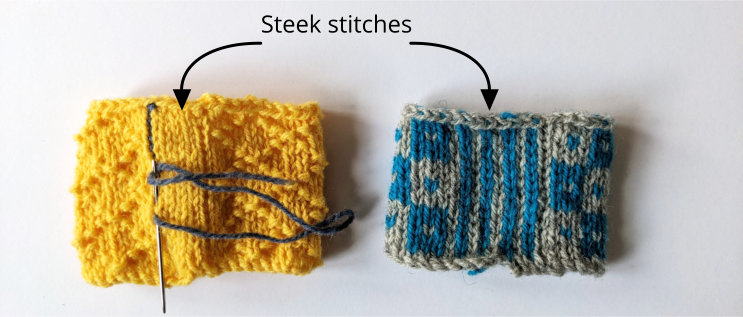
3. The scary bit: you cut through the center column of your steek stitches. I say scary, but at this stage your knitting is safe. It can't unravel once the steek stitches have been secured.
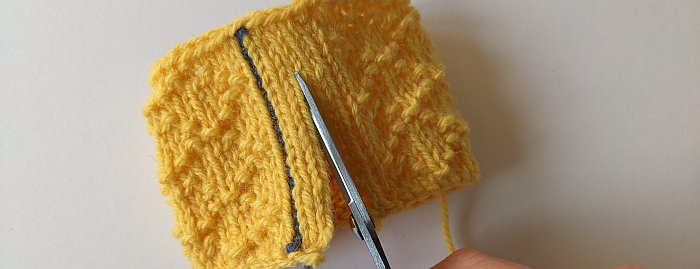
4. Finally, you hide the cut edge for extra security and to make it look pretty.
The initial photo tutorial in the book explained all this well, except it stops after the cutting stage, so didn't show how to hide the cut edge. Andrea Brauneis uses different methods for this final stage, so I can see that it might have made sense to her to only describe what to do within each pattern. For me, there are two problems with this. Firstly, that unfinished cut edge in my imagination left me feeling vaguely anxious—it formed a question that would need an answer before I could start knitting. Secondly, as is normal in patterns, the instructions for each method are fairly terse, so when I tried to find the answer, I didn't find it easy to understand. What I would have loved is a short summary showing at least the kinds of methods that are used, along with some pictures to help me see what I was supposed to do.
In case it helps anyone else feel confident enough to try this otherwise-wonderful book, I've pulled together the kind of summary that I think would have helped me. It turns out that, broadly, the patterns use one of three methods to hide the steeked edge:
1. Fold and sew it down - Fold the steek under itself on the wrong side of the work, pin into place, then sew it down.
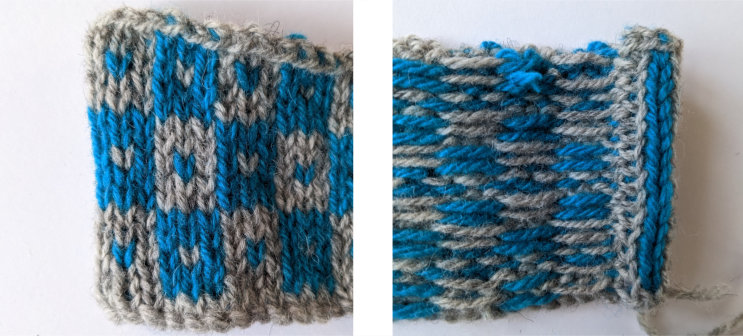
2. Cover it - pick up stitches to add a layer of fabric in front of the steek, fold the new layer to the wrong side to cover the steek, pin and sew.
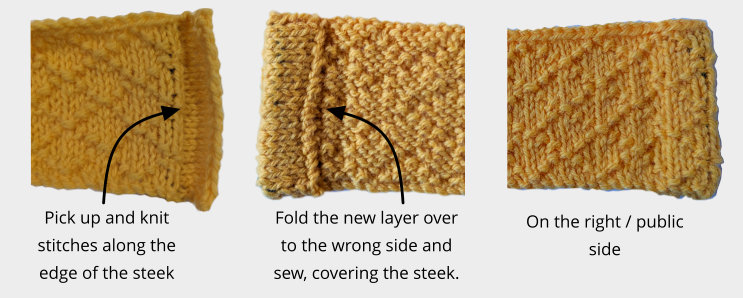
3. Enclose it in a border - Knit a border, picking up stitches in front of the steek, then add a second layer of fabric behind the steek, then join the two new layers together.
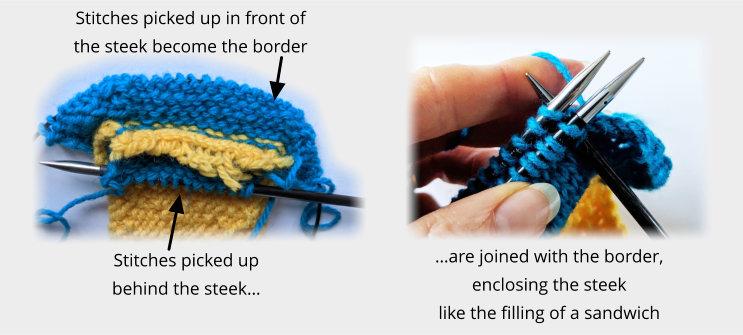
I found this book eye-opening, exciting even. It's introduced me to a method of making flat knitting that I hadn't thought about before—at least not for anything except stranded colorwork cardigans. The patterns use many different techniques besides steeking too: brioche, lace, knit/purl textures, slipped stitch colorwork, cables and, of course, stranded colorwork. I can imagine someone working their way through the book all year, learning a huge amount along the way. Think of all the beautiful knitted gifts you could have ready for Christmas 2023! If you're a knitter looking for a new challenge, Knitting Wraps In The Round might just provide it.

New and discontinued yarns

New
Alize
Wooltime
– Worsted
– 75% Superwash Wool, 25% Nylon
– Plied
– Solid colors, Self-striping (fair-isle effect)
Berroco
Lumi
– Worsted
– 80% Cotton, 18% Polyester, 2% Metallic
– Fiber core wrapped
– Semi-solid colors with metallic
Vintage Baby Handpaint
– DK
– 52% Acrylic, 40% Superwash Wool, 8% Nylon
– Plied
– Dotted colors
Emma's Yarn
Suri Silk
– Lace
– 74% Alpaca, 26% Silk
– Brushed bouclé
– Tonal colors, Multicolored, Speckles
HiKoo
Highland Lux
– Worsted
– 90% Highland Wool, 10% Kid Mohair
– Plied with a soft haze
– Solid colors, Semi-solid colors
Hobbii
Friends Wheel
– Sport
– 55% Cotton, 45% Acrylic
– S on S plied
– Solid colors
James C. Brett
Croftland Aran
– Aran
– 80% Acrylic, 20% Superwash Wool
– Plied
– Solid colors
King Cole
Cherished Baby 4-ply
– Fingering
– 100% Acrylic
– S on S plied
– Solid colors
Lana Gatto
Baby Mignon
– Lace
– 100% Merino Superwash Wool
– Plied
– Solid colors
Lana Grossa
Nordic Merino Wool
– Worsted
– 80% Merino Superwash Wool, 20% Nylon
– Plied
– Solid colors
The Tube
– Super Bulky
– 60% Cotton, 40% Nylon
– filled_tube
– Solid colors
Lion Brand
Re-Spun Roving Jumbo
– Jumbo
– 100% Polyester
– Single ply
– Marled
Malabrigo Yarn
Noventa
– Super Bulky
– 100% Merino Superwash Wool
– Single ply
– Tonal colors, Multicolored, Speckled colors
Novita
Cotton Feel
– DK
– 100% Cotton
– Plied
– Solid colors
Runo
– Aran
– 80% Wool, 20% Nylon
– Single ply
– Self-striping (gradient transition)
Plymouth Yarn
Hearty Homestead
– Super Bulky
– 100% Highland Wool
– 2 ply
– Undyed
Discontinued
Berroco
Folio
– DK
– 65% Alpaca, 35% Viscose
– Plied with a soft haze
– Solid colors, Self-striping
Topaz
– Aran
– 72% Wool, 20% Alpaca, 8% Nylon
– Single ply
– Multicolored
Zinnia
– DK
– 93% Cotton, 7% Nylon
– filled_tube
– Tweed colors
Camp Color
CC Bulky
– Bulky
– 100% Merino Superwash Wool
– Single ply
– Solid colors, Tonal colors, Multicolored
CC Fingering
– Fingering
– 100% Merino Superwash Wool
– Plied
– Solid colors, Tonal colors, Multicolored
Caron
Chunky Cupcakes
– Bulky
– 85% Acrylic, 15% Polyester
– Plied
– Self-striping (long)
DROPS Design
DROPS Big Delight
– Aran
– 100% Wool
– Single ply
– Self-striping (gradient transition)
Debbie Bliss
Iris
– Aran
– 95% Wool, 5% Cashmere
– Single ply
– Solid colors
Luna
– Fingering
– 100% Cashmere
– S on S plied
– Solid colors
Gedifra
Cottolana 4-ply
– Fingering
– 50% Cotton, 50% Superwash Wool
– Plied
– Solid colors
Juniper Moon Farm
Pod
– Sport
– 100% Organic Cotton
– Single wrapped with thread
– Solid colors
Marriner Yarns
Super Soft Baby 3-ply
– Light Fingering
– 100% Acrylic
– Plied
– White only
Mary Maxim
Rainbow
– DK
– 100% Acrylic
– 2 ply
– Self-striping (gradient marl)
Nako
Elit Baby Muare
– Worsted
– 100% Acrylic
– S on S plied
– Semi-solid colors
ONline
Linie 352 Corby
– Aran
– 45% Acrylic, 45% Superwash Wool, 10% Alpaca
– Plied with a soft haze
– Solid colors, Heathers
Regia
Eco Line 4-ply
– Fingering
– 75% Superwash Wool, 25% Nylon
– Plied
– Solid colors, Self-striping
Sandnes Garn
KlompeLompe Spøt
– DK
– 40% Alpaca, 40% Merino Superwash Wool, 20% Nylon
– Plied
– Solid colors
Sesia
S Line Hello Dolly
– Aran
– 50% Wool, 32% Viscose, 13% Kid Mohair, 5% Nylon
– Plied
– Semi-solid colors
S Line New Jersey
– Heavy Worsted
– 100% Merino Superwash Wool
– S on S plied
– Solid colors
S Line Perlage
– Worsted
– 83% Wool, 13% Synthetic, 4% Cotton
– Beaded
– Solid colors with beads
Shibui Knits
Billow
– DK
– 41% Cotton, 35% Baby Alpaca, 24% Merino Wool
– Fuzzy
– Semi-solid colors
Koan
– Fingering
– 70% Linen, 30% Silk
– Crepe
– Solid colors, Heathers
Lunar
– Lace
– 60% Merino Wool, 40% Mulberry Silk
– 2 ply
– Solid colors
Murmur
– Super Bulky
– 70% Baby Alpaca, 30% Merino Wool
– Chained
– Solid colors
Nest
– DK
– 75% Highland Wool, 25% Alpaca
– Single wrapped with thread
– Solid colors with a contrasting thread wrap
Pebble
– Light Fingering
– 48% Silk, 36% Merino Wool, 16% Cashmere
– Tweedy
– Heathered colors
Pure Cashmere
– Lace
– 100% Cashmere
– 2 ply
– Solid colors
Reed
– Fingering
– 100% Linen
– Chained
– Solid colors
Silk Cloud
– Lace
– 60% Mohair, 40% Silk
– Brushed bouclé
– Solid colors
Tweed Silk Cloud
– Lace
– 65% Silk, 35% Kid Mohair
– Fuzzy
– Solid colors, Tweedy colors
Twig
– Sport
– 46% Linen, 42% Silk, 12% Wool
– Tweedy
– Solid colors
Stacy Charles Fine Yarns
Nina
– Aran
– 77% Linen, 23% Cotton
– Chained
– Solid colors, Heathers
Patti
– Bulky
– 100% Cotton
– filled_tube
– Solid colors
Taylor
– Worsted
– 45% Wool, 30% Viscose, 25% Cashmere
– Crepe
– Solid colors, Heathers
String Yarns
Norway
– Aran
– 100% Cashmere
– S on S plied
– Marled colors
Tahki Yarns
Kaleidoscope
– Worsted
– 86% Superwash Wool, 14% Acrylic
– Single ply
– Multicolored marls
Kiawah
– DK
– 55% Wool, 45% Cotton
– Plied
– Semi-solid colors
Manchester
– Aran
– 45% Highland Wool, 35% Superfine Alpaca, 20% Acrylic
– 2 ply
– Solid colors, Heathers
Tiburon
– DK
– 50% Organic Cotton, 50% Tencel / Lyocell
– S on S plied
– Solid colors
The Yarn Collective
Hudson Worsted
– Worsted
– 85% Merino Wool, 15% Yak
– Plied
– Heathered colors
Portland Lace
– Lace
– 100% Merino Wool
– 2 ply
– Tonal colors
Three Irish Girls
Adorn Sport
– Sport
– 80% Merino Superwash Wool, 20% Nylon
– Plied
– Solid colors, Tonal colors, Multicolored
Bamboo Cotton Worsted
– Worsted
– 50% Bamboo Viscose, 50% Organic Cotton
– Plied
– Solid colors, Tonal colors, Multicolored
Finley Fingering
– Fingering
– 100% Merino Superwash Wool
– 2 ply
– Solid colors, Tonal colors, Multicolored
Glenhaven CashMerino Sock
– Fingering
– 80% Merino Superwash Wool, 10% Cashmere, 10% Nylon
– Plied
– Solid colors, Tonal colors, Multicolored
Kinsale Merino Tencel
– Fingering
– 50% Merino Wool, 50% Tencel / Lyocell
– Plied
– Solid colors, Tonal colors, Multicolored
McClellan Lace
– Lace
– 50% Bamboo Viscose, 50% Merino Superwash Wool
– 2 ply
– Solid colors, Tonal colors, Multicolored
Meara Kid Mohair
– Lace
– 86% Kid Mohair, 14% Nylon
– Brushed bouclé
– Solid colors, Tonal colors, Multicolored
Shannon Silk Mohair Stellina
– Light Fingering
– 63% Silk, 23% Mohair, 14% Metallic
– Plied with a soft haze
– Solid colors, Tonal colors, Multicolored
If you'd like to get in touch, please send a mail to hello@yarnsub.com (you can simply reply to this mail) or find me on Instagram.
See you in February!
Wendy
Disclaimer: YarnSub provides information for guidance only and doesn't guarantee its accuracy. We try hard to get it right though—please let us know if you see any issues, via email to hello@yarnsub.com.
Affiliate links: YarnSub is a participant in the Amazon Services LLC Associates Program, an affiliate advertising program designed to provide a means for sites to earn advertising fees by advertising and linking to amazon.com.
Click if you would like to unsubscribe.
![[Book: 'Knitting Wraps In The Round' by Andrea Brauneis]](https://yarnsub.com/articles/news/2023/01/knitting-wraps-in-the-round.jpg)
